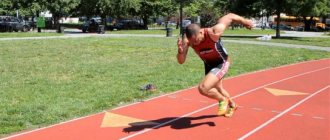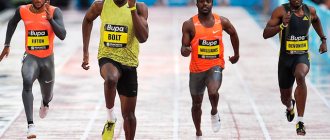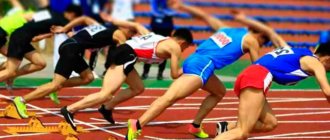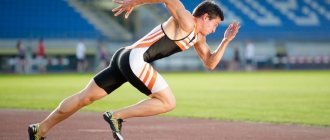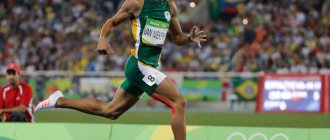Modern rules for middle distance running
Middle distance running is a sports discipline characterized by a combination of techniques. Competitions are held on running tracks of different lengths (distances), usually in a left-hand direction. Before the start, athletes are lined up 3 m from the start line. After the command is given, the runners freeze and, upon hearing the shot, begin to move.
The athlete must not touch the ground with his hands. A false start is considered to be situations in which participants fix the position and do not accept the starting position. In this case, after the shot, the runner may be removed from the race.
The 1500m race starts from the general line. An athlete who interferes with an opponent may be disqualified. The 800m race also starts from a common line. Before exiting the bend, the athlete moves along his own track.
After reaching the arc-shaped line, marked with flags on each edge, the runner continues along the common path. A runner is not removed from the competition if he left the stadium on his own due to poor health.
Who is a stayer
Translated from English, stayer means “hardy.” Endurance is the main characteristic of a stayer athlete. A stayer is a long-distance runner whose duration ranges from 2 miles or more than 3,000 meters. Athletics athletes who take part in distance races may also be called marathon runners.
It's not just people who run long distances who are called stayers. Athletes can also take part in non-running sports. This term is used to describe the psychological characteristics of a person.
Stayers are distinguished by patience, perseverance, they slowly but surely move towards the goal. They do not hope for a “second wind” that will open soon. The stayer's jerk is smooth, without sudden movements.
Features of middle distance running
During the race, you need to rationally spend your own strength . An athlete who wants to beat his opponents needs to be in close proximity to the race leader. We need to save resources for the final push. It is important to maintain distance in order to be able to bypass your opponents at any time.
Halfway through the race, most runners begin to feel tired. Breathing must be trained gradually. Frequent jerking should be avoided: it exhausts the body and reduces breathing.
Rank for men and women
Middle distance running is considered a popular sport. This discipline requires endurance from women and men. Middle distance running includes distances of 600 m, 800 m, 1000 m, 1500 m, 2000 m and 3000 m. According to the Olympic system, the most prestigious races are 3000 m (with obstacles), 1500 m and 800 m. The levels differ for men and women.
600 m
The 600m run can be considered an intermediate distance between medium and short distances.
Standards:
- Candidate for Master of Sports (CMS), completion time: for men – 1 min. 23 sec., for women – 1 min. 37 sec;
- first adult category, completion time: for men – 1 min. 28 seconds, for women – 1 minute. 44 sec.;
- second adult category, completion time: for men – 1 min. 34 sec., for women – 1 min. 51 sec;
- third adult category, completion time: for men - 1 minute. 40 sec., for women – 1 min. 57 sec;
- first youth category, completion time: for men – 1 min. 48 seconds, for women – 2 minutes. 9 sec.;
- second youth category, completion time: for men – 1 min. 54 seconds, for a woman – 2 minutes. 21 sec.;
- third youth category, completion time: for men – 2 minutes. 5 sec., women – 2 min. 33 sec.
The Russian record belongs to runner Yuri Borzakovsky (2010, 1 min. 16 sec.).
800 m
When running the 800m, the athlete must maintain a high pace. Many people consider the technique to be sprinting. Runners start separately, each from their own track.
Standards at 800 m:
- MSMK, passage time: for men - 1 min. 47 seconds, for women - 2 minutes. smooth;
- MS, transit time: for men – 1 min. 49 sec., for women – 2 min. 3 sec;
- CMS, travel time: for men - 1 min. 55 sec., for women - 2 min. 15 sec;
- first adult category, completion time: for men – 2 minutes. 2 seconds, for women – 2 minutes. 25 sec;
- second adult category, completion time: for men – 2 minutes. 9 seconds, for women – 2 minutes. 35 sec.,
- third adult category, completion time: for men – 2 minutes. 20 seconds, for women – 2 minutes. 46 sec;
- first youth category, completion time: for men - 2 minutes. 30 seconds, for women – 3 minutes. smooth;
- second youth category, completion time: for men – 2 minutes. 43 sec., for women – 3 min. 15 sec;
- third youth category, completion time: for men – 2 minutes. 56 sec., for women – 3 min. 35 sec.
During the race, you can change your technique several times, choosing the most suitable pace.
1000 m
Running 1000 m is considered a mandatory standard among military units and most educational institutions. It is not included in major competitions between countries. At the Olympic Games the distance is also not regulated.
Standards:
- CMS, passage time: for men – 2 minutes. 27 seconds, for women – 2 minutes. 55 sec;
- first adult category, completion time: for men – 2 minutes. 35 seconds, for women – 3 minutes. 5 sec.;
- second adult category, completion time: for men – 2 minutes. 48 seconds, for women – 3 minutes. 20 sec.;
- third adult category, completion time: for men – 3 minutes. 2 seconds, for women – 3 minutes. 36 sec;
- first youth category, completion time: for men – 3 minutes. 17 seconds, for women – 3 minutes. 55 sec;
- second youth category, completion time: for men – 3 minutes. 34 seconds, for women – 4 minutes. 15 sec;
- third youth category, completion time: for men – 3 minutes. 55 sec., for women – 4 min. 45 sec.
When running a 1000 m race, the first 2-3 minutes.
the athlete spends on acceleration. It is important to avoid being blocked by opponents to the left edge. After gaining speed, you can slow down slightly and run, monitoring your breathing and speed. 200-250 m before the finish the pace must be increased. Approximately 100-120 m before the end of the distance, the athlete calculates the transition.
2000 m
Running 2000 m can be classified as middle distance. Despite such a long distance, the discipline is not included in the Olympic Games program. Athletes usually overcome obstacles (pits with water).
Running standards for men (without obstacles):
- MSMK, completion time – 5 minutes. 36 sec;
- MS, transit time - 5 minutes. 36 sec;
- CMS, travel time – 5 minutes. 50 sec;
- first adult category – 6 min. 8 sec;
- second adult category, completion time – 6 minutes. 37 sec;
- third adult category, completion time – 7 minutes. 5 sec.;
- first youth category, completion time – 7 minutes. 35 sec.
Standards (steeplechase) for men:
- MSMK, completion time – 5 minutes. 45 sec;
- MS, transit time – 5 min. 45 sec;
- CMS, travel time – 6 minutes. smooth;
- first adult category, completion time – 6 minutes. 20 sec.;
- second adult category, completion time – 6 minutes. 45 sec;
- third adult category, completion time - 7 minutes. 17 sec.;
- first youth category, completion time – 7 minutes. 47 sec.
Running standards for women
Running standards without obstacles, women:
- MSMK, completion time – 6 minutes. 15 sec;
- MS, transit time – 6 minutes. 25 sec;
- CMS, travel time – 6 minutes. 42 sec;
- first adult category, completion time – 7 minutes. 8 sec;
- second adult category, completion time – 7 minutes. 41 sec;
- third adult category, completion time – 8 minutes. 18 sec.;
- first youth category, completion time – 9 minutes. 13 sec.
Standards (steeplechase) for women:
- MSMK, completion time – 6 minutes. 20 sec.;
- MS, transit time – 6 minutes. 35 sec;
- CMS, passage time - 6 minutes. 53 sec;
- first adult category, completion time – 7 minutes. 20 sec.;
- second adult category, completion time – 7 minutes. 52 sec;
- third adult category, completion time - 8 minutes. 31 sec;
- first youth category, completion time - 9 minutes. 27 sec.
Despite the fact that the discipline is not included in the register of the Olympic Games, 2000-meter running competitions are periodically held among countries. To have a world record recognized, an athlete must pass a doping test. The IAAF recognizes the result if all the rules of the race have been followed.
1500 m and 3000 m
The table shows the standards for running 1500 and 3000 m:
| Distance | Discharge | Men | Women |
| 1500 m | MSMK | 3 min. 37 sec. | 4 min. 5 sec. |
| MS | 3 min 37 sec. | 4 min. 5 sec. | |
| KMS | 3 min. 52 sec. | 4 min. 35 sec. | |
| 1 adult | 4 min. 6 sec. | 4 min. 55 sec. | |
| 2 adults | 4 min. 24 sec. | 5 minutes. 31 sec. | |
| 3 adults | 4 min. 43 sec. | 5 minutes. 44 sec. | |
| 1 youth | 5 minutes. 9 sec. | 6 min. 16 sec. | |
| 2 youth | 5 minutes. 32 sec. | 6 min. 48 sec. | |
| 3 youth | 6 min. 9 sec. | 7 min. 31 sec. | |
| 3000 m | MSMK | 7 min. 50 sec. | 8 min. 52 sec. |
| MS | 8 min. 4 sec. | 9 min. 14 sec. | |
| KMS | 8 min. 31 sec. | 9 min. 56 sec. | |
| 1 adult | 9 min. smooth | 10 min. 44 sec. | |
| 2 adults | 9 min. 45 sec. | 11 min. 38 sec. | |
| 3 adults | 10 min. 19 sec. | 12 min. 44 sec. | |
| 1 youth | 11 min. smooth. | 13 min. 49 sec. | |
| 2 youth | 12 min. smooth. | 14 min. 53 sec. | |
| 3 youth | 13 min. 19 sec. | 16 min. 11 sec. |
For a certain period of time, the athlete must run 7-8 laps around the stadium.
Story
100 meters is a sprint distance, a discipline in athletics, one of the most popular and prestigious competitions. But at the same time it is also one of the most “historical” races.
It is considered the modern equivalent of the stadium sprint race once included in the ancient Olympic Games. It was one of the five main types of pentathlon and the most prestigious competition of the Olympics of those times.
The 100-meter dash was included in the program of the modern Olympic Games in Athens in 1896 for men, and in 1928 for women. Since 1983, 100-meter races have also been held at world championships.
At the first modern Olympic Games, American runner Thomas Burke won by 12 seconds. At these Games, the lanes were separated by ropes and each runner had a unique starting and running style.
The situation has changed over time. In 1920, athletes first used a similar style of 100-meter running using starting blocks. Nowadays, the 100-meter competition is held according to strict rules established by the International Association of Athletics Federations (IAAF).
The Olympic 100m final is widely regarded as one of the most watched sporting events in athletics, with 35 million people around the world watching live when Usain Bolt won the Olympic 100m in Rio 2016.
Usain Bolt's Golden Sprint
Middle distance running technique
Middle distance running is a cross between staying and sprinting techniques.
It includes 4 stages:
- start;
- acceleration;
- distance running;
- finish.
To learn how to change your running technique during competitions, you need to train for a long time. Inexperienced athletes often make mistakes while running. The starting leg should not be placed too close to the zero (starting) line. It is important to ensure that your shoulders do not go beyond the starting line. It is also not recommended to bend your limbs before a half-squat.
It is necessary to slightly bend your legs at the knee joint. During acceleration, there is no need to throw your limbs up. The foot should be parallel to the ground.
You need to concentrate your gaze on the treadmill; it is better not to look around. To make your neck and shoulders less tired, press your chin to your chest. Hands are bent at the elbows and held at waist level, trying not to swing them. Before the chest jerk (at the finish line), the arms are pulled back slightly.
Start
Short distance races usually start with a high start. Competitors take the starting position. The push leg is thrown forward, the fly leg is left behind. The distance between the feet should be 25-35 cm. The legs are slightly bent at the knees. Athletes need to transfer their entire body weight to the front pushing leg.
The runner lowers his head, looking at the treadmill. For convenience, the brushes can be gathered into a fist. The arms are slightly bent at the elbows and completely relaxed. After placing the athletes on the treadmill, the judge or starter gives the command “Attention!”, after a few seconds he says “To the start!” With the command “March”, athletes make a powerful push from a standing position.
Overclocking
When running medium distance races, the athlete should try to accelerate to maximum speed in the first 20-40 seconds. After some time, the speed will decrease, which will allow the runner to rationally spend energy. Usually the speed at the start is much higher than the distance speed: athletes try to get ahead at the very beginning of the race.
When the participant overcomes the first 100 m of the distance, he must gradually slow down the pace. It is important to hold your ground and try to stay away from your opponents. This will not allow the latter to have the opportunity to block the leader, pushing him to the left edge of the treadmill.
Distance running
Compliance with running technique allows the athlete to reach the finish line faster than his opponents. The athlete must take up to 5 steps per second (each about 1.5-2 m long). When running, the torso is slightly tilted forward (no more than 3-5°).
The arms, bent at the elbows, move in discord with the legs. The speed of movement can be affected by the intensity of the arm swing: the more the athlete moves the upper limbs while running, the faster he will cover the distance. The upper body should be as relaxed as possible.
Finish
The athlete begins to prepare for the finish in advance. 350-300 m before the finish line, the athlete should increase the frequency of steps. At the same time, the body leans forward more, the person moves by inertia. Good results are shown by finishing acceleration or octopus. The techniques require a powerful push. The runner breaks the tape with his shoulder or chest.
Errors
- Sprint too early
Middle distances are about physical pain and its patience. Sprinting from the start line means the inability to maintain the target pace during the main distance and the failure of the finishing acceleration.
- Slow pace
But, on the other hand, if you start at a slow pace, you can immediately lose the group and have difficulty picking up the pace along the distance, because the closer the finish is, the more you will have to accelerate. As you prepare, work on a target pace so you know what speed you can maintain.
- Ignorance of competition
Some people will say, “I don’t care who runs the race, I just want to finish.” Another runner will share, “I know some of the runners are a lot stronger than me, so I’ll let them go.” The third will plan like this: “I know a couple of runners whose pace I can keep up with, so I’ll try to keep up, because with them I have a chance to achieve a better result.”
Despite the strongest field of participants, Timothy Cheruiyot was able to create an impressive lead and take gold at the World Championship. Doha 2019
How to Improve Your Middle Distance Running Technique
Middle distance running is a discipline that requires hard training . Speed is determined by the individual characteristics of the athlete’s body. It is almost impossible to increase it several times. To improve your middle-distance running technique, experts recommend training regularly and hard. It is important to be able to unlock your own potential.
First of all, you need to learn how to distribute the load. Also, special attention is paid to the condition of the muscle frame: if the fibers are in constant tension, then a person will not be able to run quickly. You can cover a long distance only in a relaxed state.
Special exercises to improve middle-distance running technique
The following factors may affect the final result:
- climatic conditions, convenience of shape;
- psycho-emotional state;
- physical or mental fatigue;
- well-being.
If an athlete does not feel well, it is better to refuse the competition.
Improving your middle-distance running technique should focus on working on the basic aspects. An athlete can achieve maximum results if he sets a clear goal for himself in advance. Training should be carried out regularly, at least 3 times a week. It is best to practice under the supervision of an experienced trainer: he will help you create a competent and clear program.
It should include strength exercises. The runner trains the lower limbs to be able to jump high, push off the ground and instantly accelerate in 10-15 seconds. Jumping movements need to be given special attention. At the initial stages of training, the athlete covers short distances (60 m, 100 m, 150 m, 200 m).
Warm up before running
During the first lessons with a trainer, they perform strength and jumping exercises, then carefully work on their running technique. The athlete must learn to step from toe to heel to minimize the risk of injury and be able to evenly distribute the load on the foot.
Exercises to improve results
Middle distance running is a competition between several people.
The following exercises should be included in your training program:
- Resistance in pair . An elastic band is wrapped around the waist of one of the athletes. The second runner takes both ends in his hands. The opponents stand with each other's backs and try to move in the opposite direction. Thus, you need to overcome 7-10 m. Perform 10 repetitions per workout.
- Running with hops . This exercise allows you to train your muscles and stretch your steps in height and length.
- Jumping on one leg . Raise the right leg and perform 10 jumps on the left leg. Then the pushing leg is changed. Perform 10 repetitions.
- Jumping with obstacles . Objects up to 60-80 cm high are placed on the treadmill. 10 objects should be arranged in a checkerboard pattern. The distance between them is 60-70 cm. While running, the athlete must jump over obstacles.
The program also includes:
- jumping rope;
- jumping with a lunge (in this case, legs change in the air);
- jumping from a half-squat position (legs bent at the knees and try to jump as high as possible).
During training, you need to perform 10 repetitions of each exercise. To increase your running speed, you need to periodically alternate between sprinting and jogging. The duration of the workout is 3-5 hours. Periodically, the body needs to be given a rest.
The main task of a coach is to teach an athlete to overcome long distances . Training should take place at the athlete’s usual pace. It is necessary to explain to the athlete that in pairs races he should not try to overtake his opponents.
Training is best done outdoors twice a day (morning and evening). Skipping classes is not recommended: the athlete must tune in to the result, regardless of his mood.
Speed
For competitive marathon runners, this is the main reason for the whole idea of exploring the possibilities and optimizing the work of their own biomechanical complex.
Running speed = stride length x cadence.
This simple equation captures the essence of running. In order to run faster, we need to increase either the cadence or the distance from one landing point to another. Or better yet, both.
Professional athletes run with the highest possible frequency and stride length. However, they are in a balanced ratio and do not exceed the body’s ability to maintain a given pace for a long time. That is why the cadence of the elite does not fall below 180 steps per minute, but rarely exceeds 210 steps/min.
Not because specialists in biomechanics and sports physiology decided so, but because an organism prepared by training (especially the cardiovascular system) can work with such numbers, reaching maximum speed and maintaining it for a long time.
Some running theories, such as chi running, claim that to increase your pace you only need to increase your stride length while keeping your stride frequency constant. These theories are at odds with the practice and opinion of most top athletes, who say that the most optimal and effective option is to increase both parameters.
In some cases (in support of the qi theory), you can hear that the elite runs almost without changing the cadence, but playing only with the length of the step. But the word “almost” is key because, given that stride lengths in marathons are closer to a couple of meters, a change in frequency of two or three steps per minute can leave you far behind in the short term.
Proper nutrition and breathing technique for middle distance running
It is important to breathe properly while running. Athletes usually warm up before a race. While running, inhaling should work not only the chest, but also the diaphragm. The intensity of exhalations and inhalations is maintained throughout the competition. You need to breathe deeply: the lungs must be completely empty of air.
To minimize the risk of asphyxia while running, you need to every 3-4 minutes. take a deep breath. The athlete should try to maintain even breathing (2 short breaths, 1 deep exhalation). Up to 45 cycles are performed per minute.
Nutrition is also an important condition for maintaining the body in the right shape. Eating is possible no later than 100-120 minutes. before the start of the workout. Food must have time to digest in the stomach. The diet is based on the individual characteristics of the human body. Nutrition must be fully consistent with the athlete’s lifestyle and lifestyle.
You can periodically allow yourself prohibited foods (no more than once a week). After 60 min. Once you start training, your body will need fuel, so you can eat a nut butter sandwich or a protein bar.
Professional athletes recommend taking nutritional supplements that contain vitamin D, iron and fatty acids. A runner should partially eliminate white bread from his diet. It is replaced with grain or rye.
It is strictly forbidden to skip breakfast. Even if a person does not feel hungry, he needs to eat a light vegetable and fruit salad. You are allowed to drink smoothies to which parsley, spinach, cucumbers, apples, arugula or mint are added. Nutritionists recommend eating as many seasonal vegetables and fruits as possible.
Middle distance running requires endurance. Athletes interested in this sport must train regularly. Following basic nutritional rules allows you not only to maintain normal weight, but also to build muscle mass.
The right attitude
Having the right mindset before training makes it more effective. It's good to sit down and relax before class . Do breathing exercises and sit in this state for two minutes. Then take a deep breath, open your eyes and start warming up.
The simplest exercise for breathing exercises: sit comfortably, close your eyes and gently inhale air through your nose for seven counts. After counting to seven, pause and exhale air, also smoothly, for seven counts. Pause again and the exercise starts again. Do such cycles 2-3 times.

